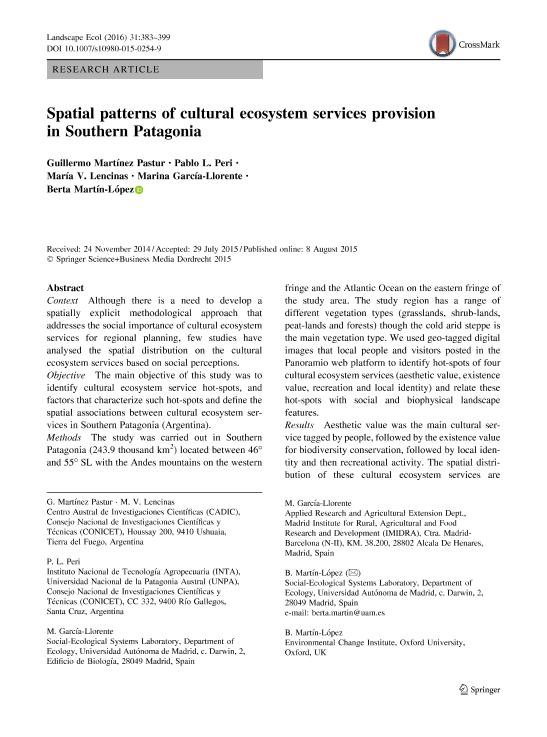Artículo
Spatial patterns of cultural ecosystem services provision in Southern Patagonia
Martínez Pastur, Guillermo José ; Peri, Pablo Luis
; Peri, Pablo Luis ; Lencinas, María Vanessa
; Lencinas, María Vanessa ; García Llorente, Marina; Martín López, Berta
; García Llorente, Marina; Martín López, Berta
 ; Peri, Pablo Luis
; Peri, Pablo Luis ; Lencinas, María Vanessa
; Lencinas, María Vanessa ; García Llorente, Marina; Martín López, Berta
; García Llorente, Marina; Martín López, Berta
Fecha de publicación:
02/2016
Editorial:
Springer
Revista:
Landscape Ecology
ISSN:
0921-2973
Idioma:
Inglés
Tipo de recurso:
Artículo publicado
Clasificación temática:
Resumen
CONTEXT: Although there is a need to develop a spatially explicit methodological approach that addresses the social importance of cultural ecosystem services for regional planning, few studies have analysed the spatial distribution on the cultural ecosystem services based on social perceptions.
OBJECTIVE: The main objective of this study was to identify cultural ecosystem service hot-spots, and factors that characterize such hot-spots and define the spatial associations between cultural ecosystem services in Southern Patagonia (Argentina).
METHODS: The study was carried out in Southern Patagonia (243.9 thousand km2) located between 46° and 55° SL with the Andes mountains on the western fringe and the Atlantic Ocean on the eastern fringe of the study area. The study region has a range of different vegetation types (grasslands, shrub-lands, peat-lands and forests) though the cold arid steppe is the main vegetation type. We used geo-tagged digital images that local people and visitors posted in the Panoramio web platform to identify hot-spots of four cultural ecosystem services (aesthetic value, existence value, recreation and local identity) and relate these hot-spots with social and biophysical landscape features.
RESULTS: Aesthetic value was the main cultural service tagged by people, followed by the existence value for biodiversity conservation, followed by local identity and then recreational activity. The spatial distribution of these cultural ecosystem services are associated with different social and biophysical characteristics, such as the presence of water bodies, vegetation types, marine and terrestrial fauna, protected areas, urbanization, accessibility and tourism offer. The most important factors are the presence of water in Santa Cruz and tourism offer in Tierra del Fuego.
CONCLUSIONS: Our results demonstrate that this methodology is useful for assessing cultural ecosystem services at the regional scale, especially in areas with low data availability and field accessibility, such as Southern Patagonia. We also identify new research challenges that can be addressed in cultural ecosystem services research through the use of this method.
Archivos asociados
Licencia
Identificadores
Colecciones
Articulos(CADIC)
Articulos de CENTRO AUSTRAL DE INVESTIGACIONES CIENTIFICAS
Articulos de CENTRO AUSTRAL DE INVESTIGACIONES CIENTIFICAS
Articulos(SEDE CENTRAL)
Articulos de SEDE CENTRAL
Articulos de SEDE CENTRAL
Citación
Martínez Pastur, Guillermo José; Peri, Pablo Luis; Lencinas, María Vanessa; García Llorente, Marina; Martín López, Berta; Spatial patterns of cultural ecosystem services provision in Southern Patagonia; Springer; Landscape Ecology; 31; 2; 2-2016; 383-399
Compartir
Altmétricas



